Who Controls the User Experience? AMD’s Carrizo Thoroughly Tested
by Ian Cutress on February 4, 2016 8:00 AM ESTBenchmark Results: Professional and OpenCL
Here are our results from our Professional and OpenCL tests. A reminder of our systems, including their graphics:
| System Overview | ||||
| µArch | APU + GPU | Memory | Channel | |
| HP Elitebook 745 G2 | Kaveri | A10 PRO-7350B (19W) R6, 384 SPs, 533 MHz |
8 GB | Dual |
| HP Elitebook 745 G3 | Carrizo | PRO A12-8800B (15W) R7, 512 SPs, 800 MHz |
4 GB | Single |
| Toshiba Satellite E45DW-C4210 |
Carrizo | FX-8800P (15W) R7, 512 SPs, 800 MHz |
8 GB | Single |
| HP Pavilion 17z-g100 |
Carrizo | A10-8700P (15W) R6, 384 SPs, 800 MHz |
8 GB | Single |
| Lenovo Y700 | Carrizo | FX-8800P (15W) R7, 512 SPs, 800 MHz R9 385MX, 512 SPs, 900-100 MHz |
16 GB | Single |
PCMark 08
PCMark08, developed by Futuremark, is a simple press play and run benchmarking tool designed to probe how well systems cope with a variety of standard tasks that a professional user might encounter. This includes video conferencing with multiple streams, image/file manipulation, video processing, 3D modelling and other tools. In this case we take the three main benchmark sets, Creative, Home and Work, and run them in OpenCL mode which aims to take advantage of OpenCL accelerated hardware. For fun we also put in the PCMark08 Storage workset.
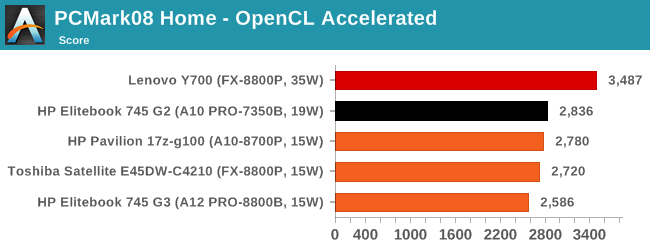
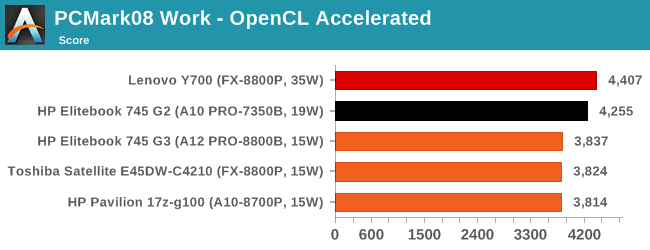
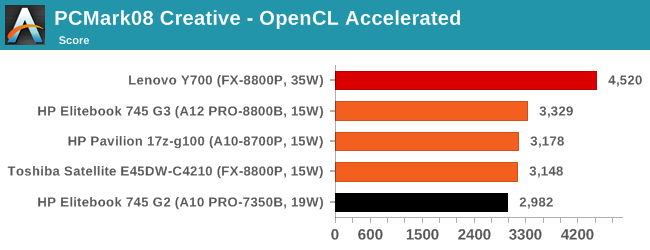
Both of the Home and Work tests show something starteling in the Kaveri system beating all the 15W Carrizo parts. This comes back to what we saw on WebXPRT on the last page – these workloads are very bursty in nature, requiring the system to wake up, run a small amount of work, and go back to sleep. It would seem that this requires a lot more effort from the Carrizo platforms than the Kaveri ones (perhaps by nature of the lower idle power draw starting point on Carrizo) which impacts time critical performance metrics.
If we take the CPU frequencies of the two Elitebook systems, starting with the 745 G2 (Kaveri)
Here the standard frequency tends to be in the 3300 MHz region, moving down to lower frequencies when more threads are needed. But for the 745 G3 (Carrizo):
Here the CPU frequency is obviously mostly at the 2500 MHz mark, sometimes bursting up to 3400 MHz (It’s actually more of a 2:1 split in favor of 2500 MHz).
You might argue that the temperature of the design might be to blame. Both Elitebooks are in the same chassis, so let us see:
(take note of the scales)
Here it shows the G2 wanting to stay below 60C, whereas the G3 is happy to go almost to 80C, albeit with an average temperature which is nearer 50C. This means that the G2 can arguably keep the higher frequencies for longer.
Just to weigh in on the other 15W Carrizo designs in the Toshiba Satellite and HP Pavilion:
In both cases, similar to the G3, the main frequency for the test is actually the lower 2500/2300 frequency, with the system moving up to the higher frequency state around a third of the time, rather than staying at the higher state and moving back down. This is what is causing the Kaveri system to win out in these sorts of workloads (though likely at a power penalty).
On the storage front, having a mechanical drive is a killer here.

Agisoft Photoscan
Photoscan is professional software that takes a series of 2D images (as little as 50, usually 250+) and 'performs calculations' to determine where the pictures were taken and if it can create a 3D model and textures of what the images are of. This model can then be exported to other software for touch-ups or implementation in physics engines/games or, as the reader that directed me to it, national archiving. The tool has four phases, one of which can be OpenCL accelerated, while the other three are a mix of single thread and variable thread workloads. We ran the tool in CPU only and OpenCL modes.
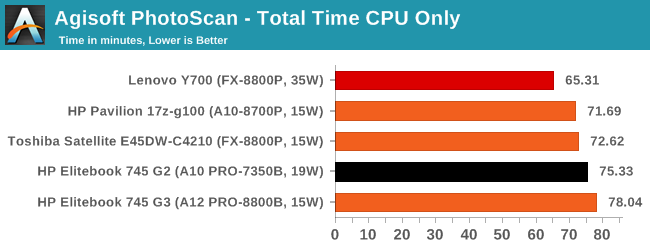
When pure CPU performance matters, having the higher thermal headroom matters most. But moving it to the OpenCL mode shows that those extra TDP points can matter a lot on load balancing:
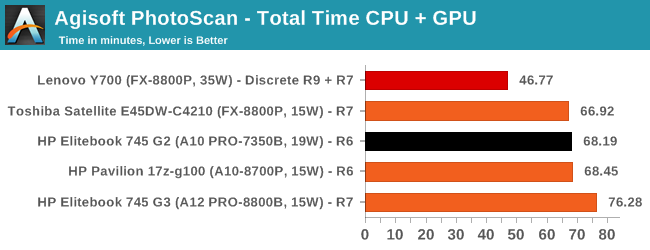
There are two things to note here. One, something seems to have gone very wrong with the G3, and I’m sure those numbers are erroneous and need to be re-run or the 4GB of memory is actually a hindrance here. The second is that the combination R7/R9 graphics in the Lenovo, despite not being in Crossfire, can both be used in OpenCL mode. This pushes a speed up of almost 30%.
Linux Bench
Linux Bench is a collection of Linux based benchmarks compiled together by ServeTheHome. The idea for this is to have some non-windows based tools that are easy enough to run with a USB key, an internet connection and three lines of code in a terminal. The tests in Linux Bench include standard synthetic compute, compression, matrix manipulation, database tools and key-value storage.
Unfortunately Linux Bench refused to run on any of the HP systems for relatively unknown reasons – the fact that it was all the HP models perhaps means that there is something firmware related which is causing the LiveCD to not boot properly. Nonetheless, the results are here for completeness.
| Linux Bench | ||
| Toshiba Satellite E45DW-C4210 (15W) |
Lenovo Y700 (35W) |
|
| C-Ray Hard Test / seconds | 365 | 267 |
| 7-Zip Compression MIPS | 5718 | 6110 |
| 7-Zip Decompression MIPS | 7320 | 9733 |
| NAMD (steps per time) | 1.72 | 2.46 |
| NPB MOPS (per sec per thread) | 365 | 321 |
| OpenSSL Sign | 220 | 296 |
| OpenSSL Verify | 13518 | 19465 |
| Redis 1 | 13210 | 12034 |
| Redis 10 | 41494 | 38760 |
| Redis 100 | 33445 | 31949 |






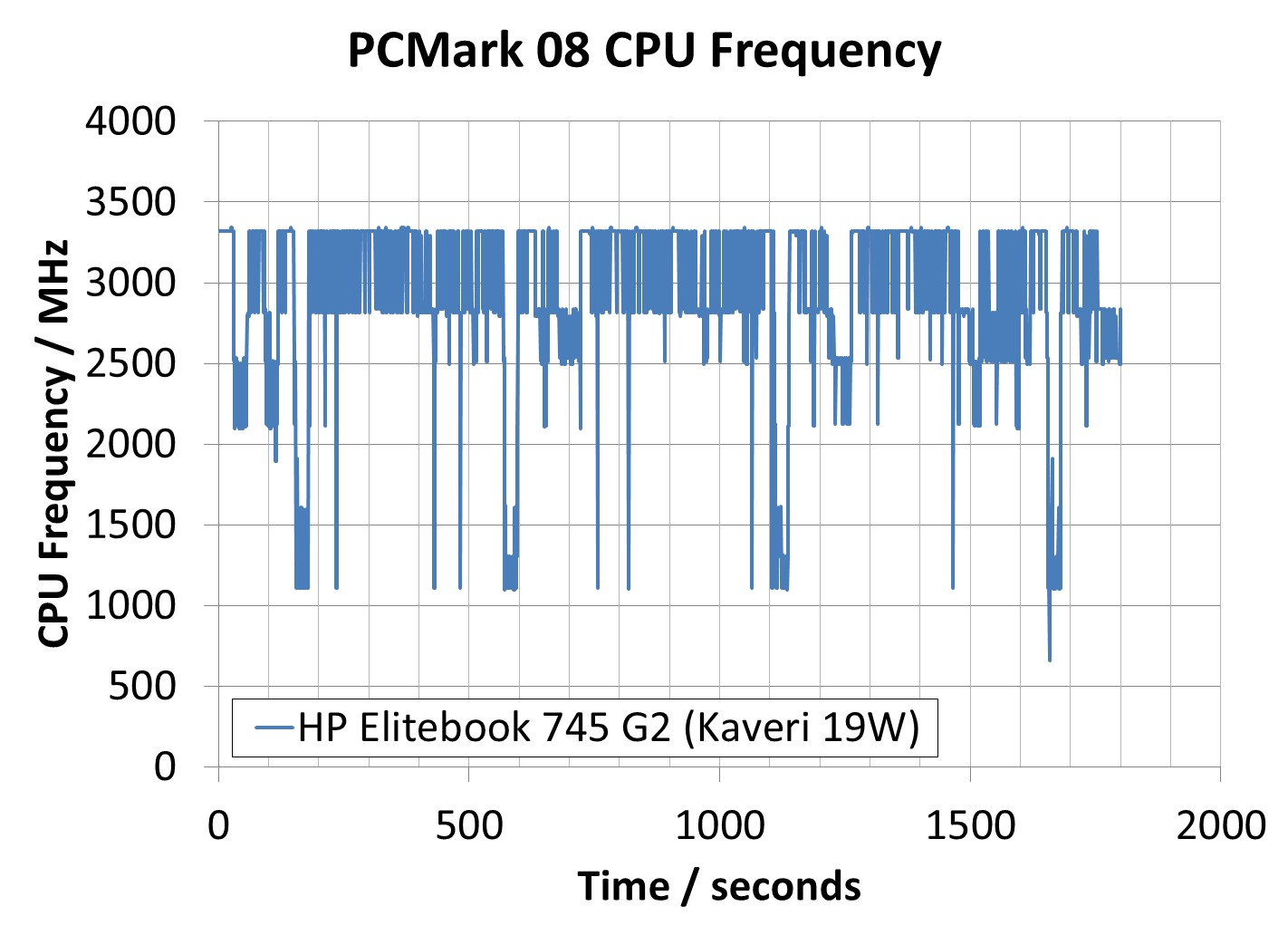

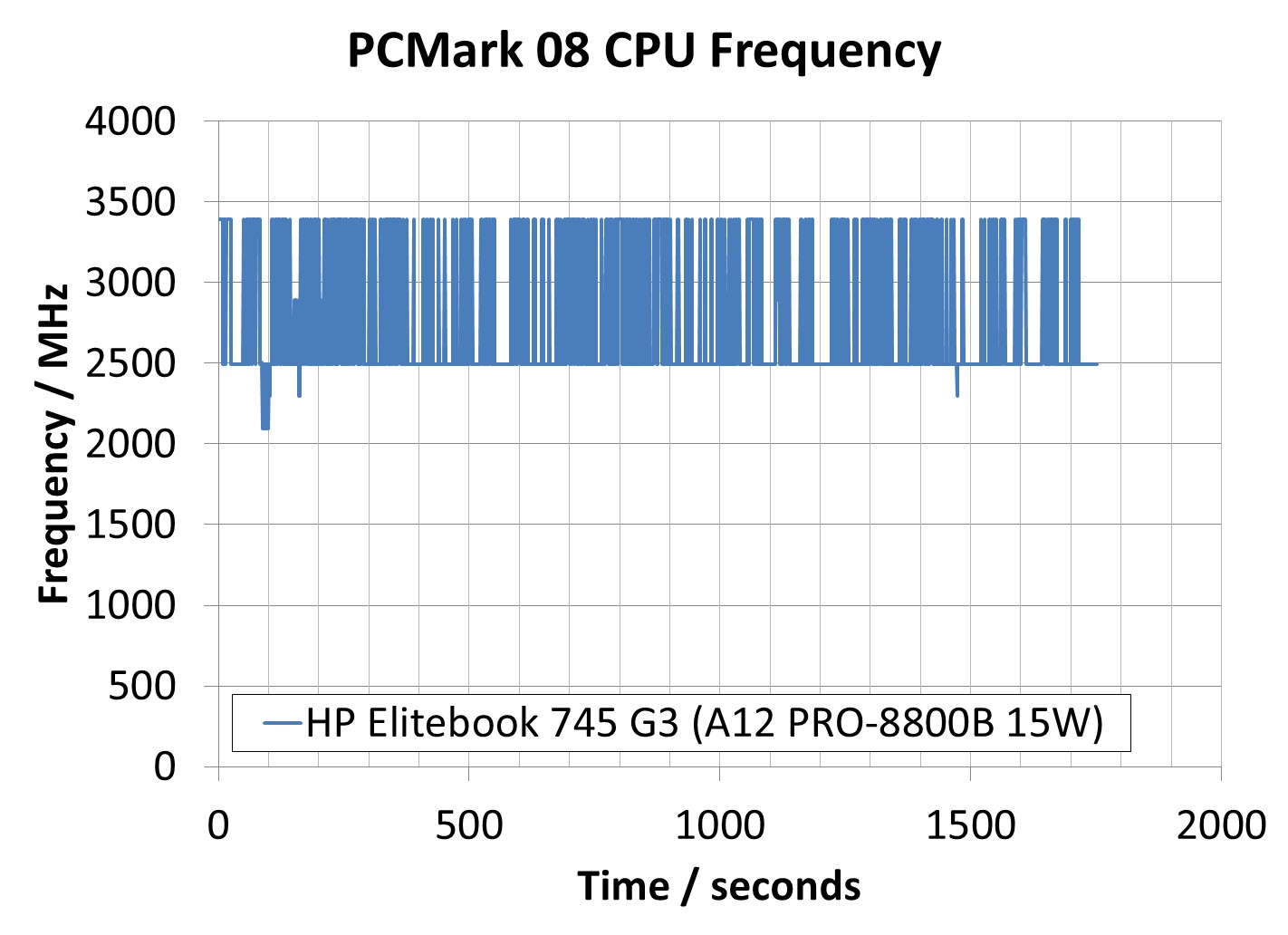
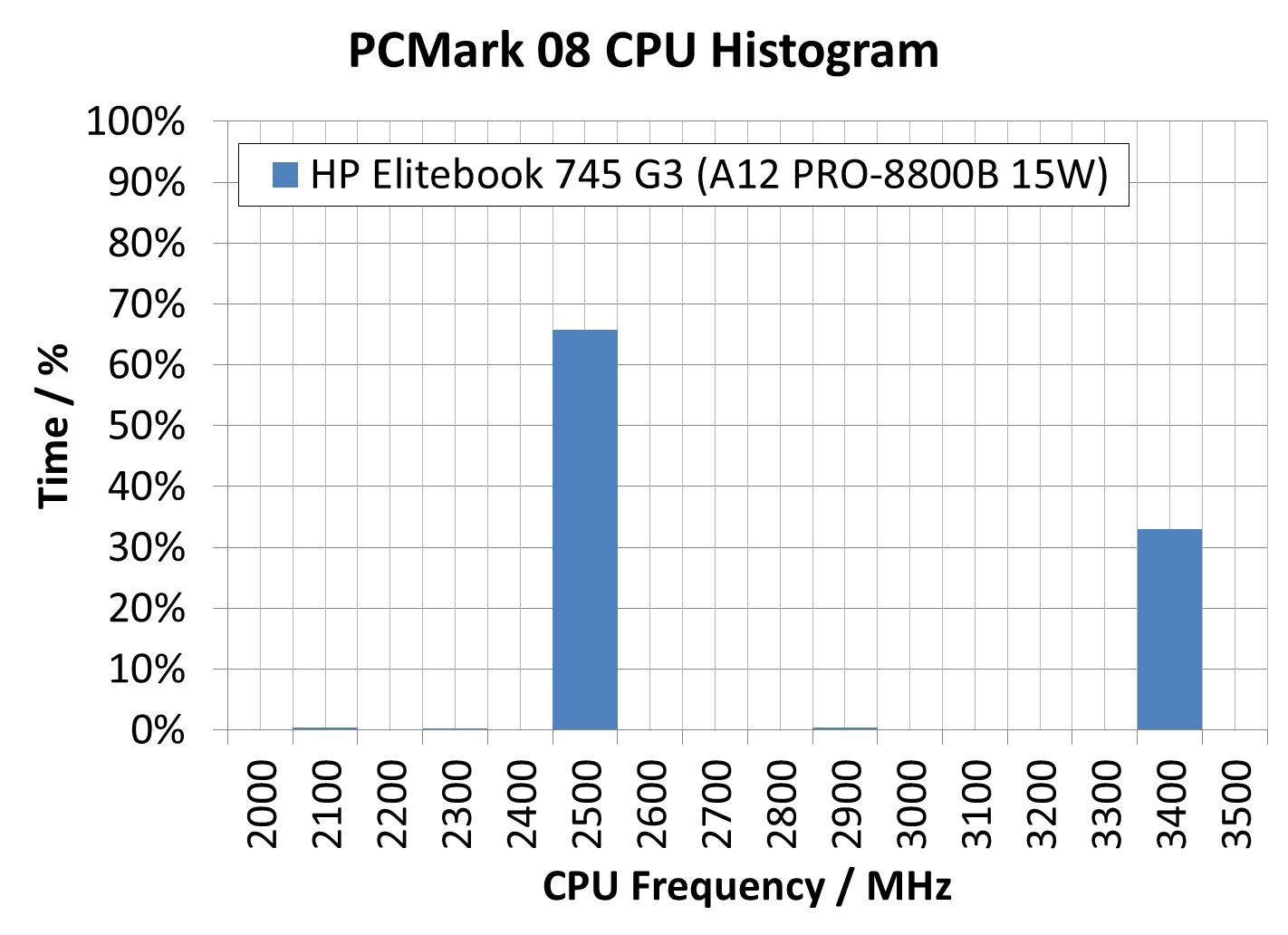

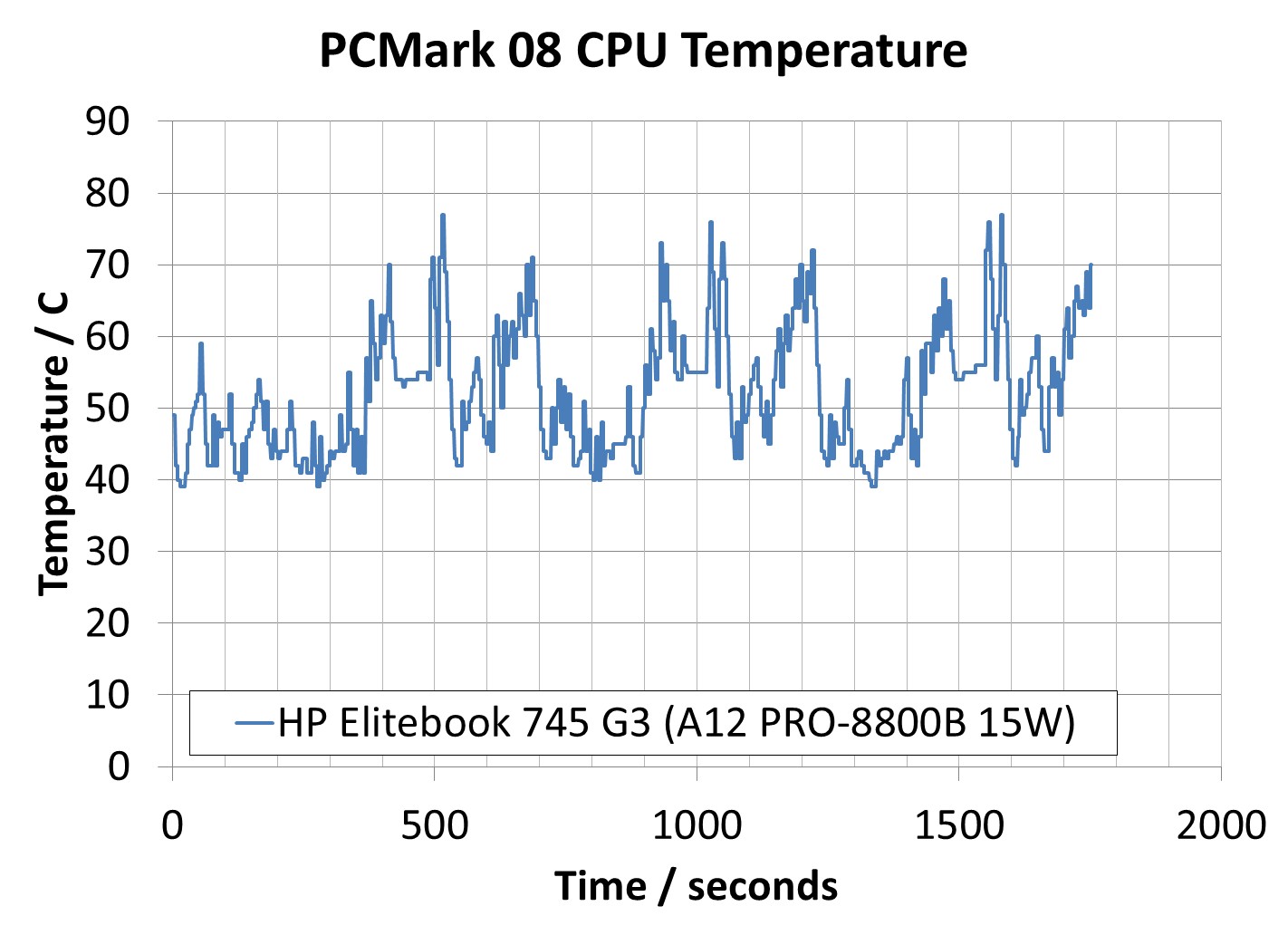










175 Comments
View All Comments
yannigr2 - Friday, February 5, 2016 - link
The 845 doesn't have an iGPU. You threw away the chance to directly compare the color compression advantage of Carrizo's GPU in a very limited bandwidth scenario like this one by either removing one dimm from the Kaveri laptop or adding another one in one of the Carrizo laptops. I wouldn't ask why. Thanks for the article.FriendlyUser - Saturday, February 6, 2016 - link
Thank you for this extensive article. Many people seem to dismiss AMD CPUs today without actual data. I commend your efforts to examine all aspects of real systems. I'll be waiting for the data from 845 (which sound like a decent upgrade for a NAS...).Keep up the good work.
JMC2000 - Sunday, February 7, 2016 - link
This is something I've been interested in since AMD released the 845 (wasn't there a Phenom II-based Athlon 845? I know there was a Phenom II 845...). Shame that they chose not to release an A12/FX Carrizo APU, those 512 shaders could be nice...mczak - Friday, February 5, 2016 - link
I agree with that, it's _really_ missing results with dual channel. I understand why single-dimm configurations were tested, but at least two of the notebooks had the option to use dual channel, and even if it might be difficult to get preconfigured options with dual-channel, it's easily upgradeable - I'm also interested in what Carrizo can do as a chip, not only what it can do if sufficiently crippled by the OEM.(Not that I expect wonders with dual channel though, at least not at 15W where the graphics doesn't run with more than half the max clock anyway, but still...)
Ian Cutress - Friday, February 5, 2016 - link
On the chip side, we'll do a full breakdown of perf and IPC when we get our hands on the desktop version in Athlon X4 845. I'm hoping to get some R-Series too, and we can do DDR3 vs DDR4 on AMD as well. That might provide a better pure comparison which I know some users want to see. I do too :)bojblaz - Friday, February 5, 2016 - link
Excellent, excellent article. Lucid questions asked and answers pursued - we need more of this kind of journalism. I can't praise this enough.It would have been really interesting to see the results had you filled the second SODIMM on the laptops that supported dual channel? I assumed time constraints prevented you from doing so. Also any chance of going to the OEMs directly and asking them why they make the decisions they make?
Lolimaster - Friday, February 5, 2016 - link
That's like givin 5 tons of deadweight to pre-Raditz-Vegeta saga Goku. AMD, why even bother, release your products under Ruby brand or something...TheinsanegamerN - Thursday, February 11, 2016 - link
I second that. A proper 13 inch design with a 35 watt 8800p, none of this hybrid graphics stuff, and good battery life, would be an insta-buy. Or 14 or 15 inch. I just want something like my old lenovo e535, but smaller. It cant be THAT hard, can it?nfriedly - Sunday, February 7, 2016 - link
Agreed. This article was basically a long-winded way of saying "all current AMD laptops suck, and we aren't even sure how good they could be because *all* the OEMs half-assed their designs"I, for one, would be very interested in an AMD designed laptop.
Cryio - Sunday, February 7, 2016 - link
Apparently AMD wants to push 28 nm even farther with Bristol Ridge, maybe better binned chips and hopefully DDR4 support will provide a much needed boost.